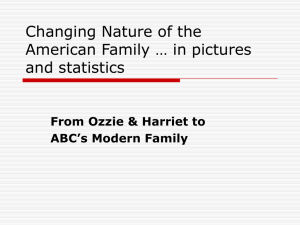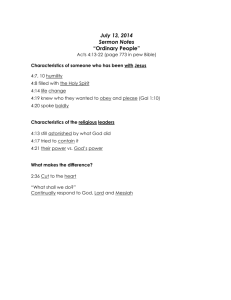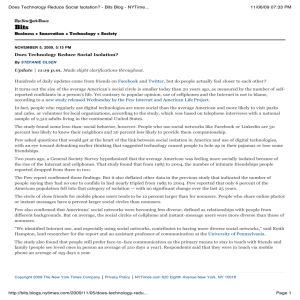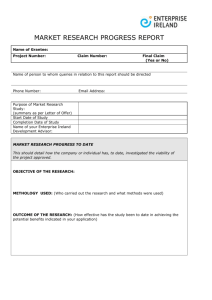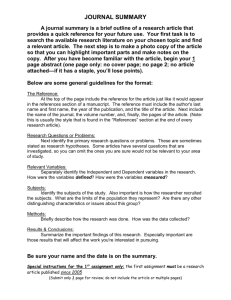File - AP Statistics
advertisement
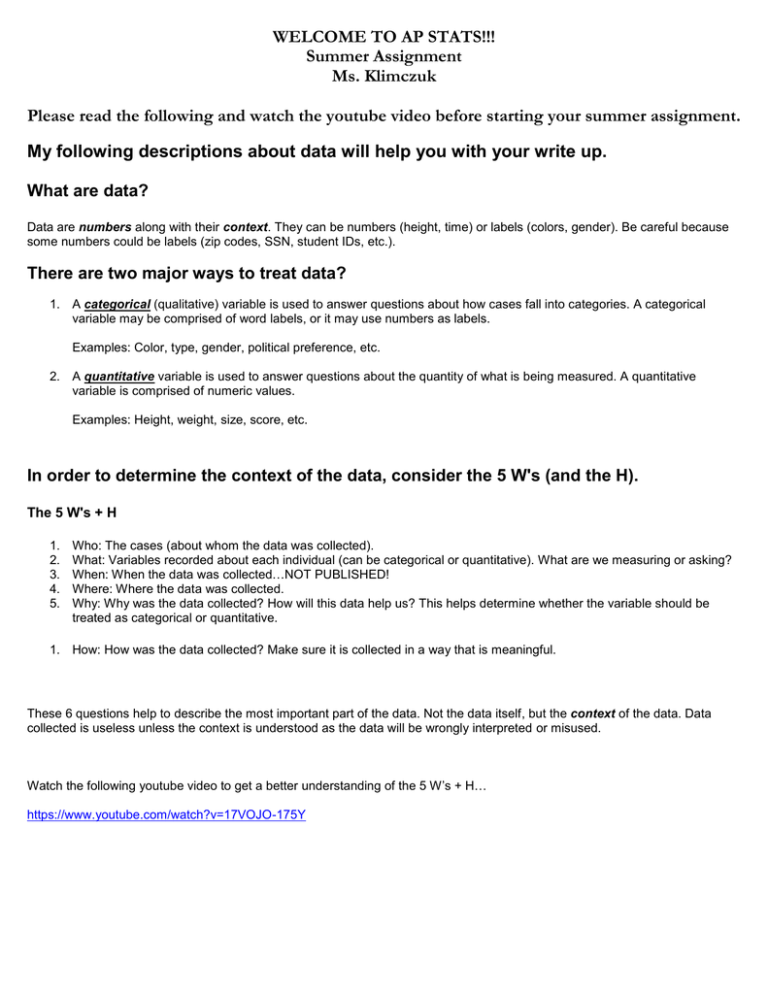
WELCOME TO AP STATS!!! Summer Assignment Ms. Klimczuk Please read the following and watch the youtube video before starting your summer assignment. My following descriptions about data will help you with your write up. What are data? Data are numbers along with their context. They can be numbers (height, time) or labels (colors, gender). Be careful because some numbers could be labels (zip codes, SSN, student IDs, etc.). There are two major ways to treat data? 1. A categorical (qualitative) variable is used to answer questions about how cases fall into categories. A categorical variable may be comprised of word labels, or it may use numbers as labels. Examples: Color, type, gender, political preference, etc. 2. A quantitative variable is used to answer questions about the quantity of what is being measured. A quantitative variable is comprised of numeric values. Examples: Height, weight, size, score, etc. In order to determine the context of the data, consider the 5 W's (and the H). The 5 W's + H 1. 2. 3. 4. 5. Who: The cases (about whom the data was collected). What: Variables recorded about each individual (can be categorical or quantitative). What are we measuring or asking? When: When the data was collected…NOT PUBLISHED! Where: Where the data was collected. Why: Why was the data collected? How will this data help us? This helps determine whether the variable should be treated as categorical or quantitative. 1. How: How was the data collected? Make sure it is collected in a way that is meaningful. These 6 questions help to describe the most important part of the data. Not the data itself, but the context of the data. Data collected is useless unless the context is understood as the data will be wrongly interpreted or misused. Watch the following youtube video to get a better understanding of the 5 W’s + H… https://www.youtube.com/watch?v=17VOJO-175Y Assignment 1: Write down one statistic that you heard in the media that you think was really funny, cool, weird, etc. Write a short description of the statistic and why you thought it was interesting. We will share these on the first day of class. Assignment 2: Review of Great Statistical Research Reports about anything that interests YOU From the Pew Research Center 1. Find one research report that strongly interests you from the Pew Research Center (pewresearch.org) that focuses on statistical analysis and strongly interests you. You MUST get the article approved by me before Friday, June 19th. No two people are allowed to do the same article. 2. Read and re-read the report/article. Underline. Take notes. Think deeply about the statistics. Use the internet to look up words that you are not familiar. 3. Write up the report/article in the format of the example write up. It is from Pew Research Center’s A Rising Share of Young Adults Live in Their Parent’s Home. Title of report/article with Reviewed by… in the format given. Source(s): URL. If you go to a referred site, list that, too. 5 W’s + H: Make sure you are correctly identifying the Who and What. These can be tricky. Abstract: A summary of the report/article to tell the reader: (1) What was investigated, (2) How it was investigated, and (3) What were the conclusions. Quantify (dates, numbers, and percentages). 4 C’s: Complete (has all components). Concise (Not a word that is redundant). Clear (Clarifies all words -nouns and verbs). CONTEXT (What do you want your reader to remember from this article?) Have someone else read it to see if they understand. If not, rewrite. Comments: A minimum of three comments from you including: (1) What was investigated, (2) How it was investigated, and (3) What were the conclusions. YOUR OWN REFLECTIONS on the report/article. Imagine yourself talking to a friend (in AP Stat) and say, “Yeah! I read the article and it said….. But, what I think is…..) 4. Hand in the write up on the first day of class. Title & 5W + 1H Possible Points 10 Abstract What was investigated How it was investigated What were the conclusions 10 10 10 Comments What was investigated How it was investigated What were the conclusions 10 10 10 Clear. Complete. Concise. Context. 30 TOTAL 100 Points Earned A Rising Share of Young Adults Live in Their Parent’s Home (August 1st, 2013) Reviewed by Ms. Klimczuk (June 15th, 2015) Source: http://www.pewsocialtrends.org/2013/08/01/a-rising-share-of-young-adults-live-in-theirparents-home/ Who: Young adults (Ages 18 – 31) What: Percentage of young adults living in their parent’s home When: 2012 Where: United States Why: The data helps us understand the economic, educational, and cultural factors that impact young adult living arrangements. How: The analysis of young adult living arrangements is based on the March Current Population Survey (CPS). The specific files used in this report are from March 1968 – March 2012. It is conducted jointly by the U.S. Census Bureau and the Bureau of Labor Statistics. Abstract By analyzing data about living arrangements from March 1968 to March 2012, the Pew Project for Social and Demographic Trends has determined the percentage of young adults (ages 18 – 31) living with their parents has increased to 36%. There are many factors that are causing this change. The amount of young adults that are employed has decreased from 70% in 2007 to 63% in 2012. Unemployed young adults are more likely to live with their parents. Increased college enrollment is also a major factor. Those enrolled in college are more likely to be living with their parents. The number of young adults enrolled in college has increased from 35% in 2007 to 39% in 2012. Pew considers college students living in dorms as still living with their parents. There are also fewer young adults getting married and those that are unmarried are more likely to live with their parents. Only 25% of young adults were married in 2012 compared to the 30% in 2007. Pew documents its methodology of calculating percentages by explaining the data obtained from the March Current Population Survey (CPS). They collected data from approximately 75,000 households and used this sample to make inferences about the nation as a whole. There are also many more trends related to the number of young adults living at home, and over time, we are seeing drastic changes happen within households. Comments 1. I think that it is interesting to see more young adults living with their parents. What I would like to know is how accurate these findings are. Only 75,000 households were surveyed, which only accounts for a small amount of the US population. However, the way that they selected their sample was done with care. They made sure to represent the civilian, non-institutionalized population. This did not include people living in institutions or the armed forces. The explanation they provide about the variable definition and sampling error gives me confidence in their results. 2. By having trained professionals survey the population, Pew was able to dig into data and discuss the main reasons that young adults still live with their parents. They use a variety of graphs and charts that are very easy to read and show many different trends. They discuss gender, age groups, education, etc. 3. I was surprised to see that the share of young adults living in their parent’s home was relatively constant from 1968 to 2007 (32%). Household arrangements changed dramatically during this period, so it is interesting to see the same percentage of young adults still living with their parents. There has been more change in the number of adults living with their parents in 5 years (2007-2012) than those 39 years (1968-2007). Shopping list: TEXTBOOK: STATS Modeling the World: 4th Edition (http://wps.aw.com/aw_bock_statsmodworld_4/) Graphing Calculators: Required for in-class and homework (TI-83 plus or TI-84 plus). Barron's AP Statistics Flashcards (http://www.amazon.com/Barrons-Statistics-FlashCards-Preparation/dp/0764194100):
